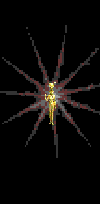









Ra explained to Hathor she had three days in which to teach humankind a lesson in respect to their creator. Hathor assumed the form of leopard and went to earth. Ra went to bed.
The next day, he looked down and was in complete shock to see Hathor had killed almost everyone on earth. He realized he needed to act quickly or there would not be anyone left to worship him. That night, Ra took on human shape and went to earth. He found blood as high as a man's chest running through the streets. Thinking quickly, he added barley and dates to the blood and then left the scene.
Before killing the remaining people, Hathor smelled the fermented beer and began to lap it up. She staggered into the shadows and fell asleep for two days and nights. When she woke, her time for killing had passed. The human race was saved. Beer had been born. ( and picnics and football games were invented to make use of this WONDERFUL discovery....)
Extracted from The Importance of Goddesses in Brewing Beer




Now that the Laughing Time has passed, [and I do hope you enjoyed that story about Hathor, it is one of my favorites] here are some of my more serious thoughts about Hathor, ocasionally referred to as Ahatoor


"The Goddess of A Thousand Names."
A list ot the Names of Splendor of the ancient Egyptian goddess Hathor (Hat-hor) might well be called the "Divine Lady of a Million Attributes,", as her major titles would easily fill more than a couple of pages of small print in any history of religions text. On the other hand, the mysterious goddess might equally be called the "Lady of No Name," for none of those many titles was a personal name in the sense that Sarasvati, Diana, or Amatersu are female names. How could one of the most popular and enduring institutions of the Two Lands have been a divinity with no name?
Part of the answer to this question can be found in the fact that the Egyptians were reluctant to mention the personal names of some gods, preferring rather to use their titles when speaking of them. Another reason can probably be traced to the title Hat-hor, or Ahatoor, (house/temple/womb of Horus) being an artifical construction of the Old Kingdom Ra/Horus priesthood. It may well be that this particular title was purposely adopted as part of a plan extend Ra/Horus propaganda and to obscure the goddess's true origins.
As the "house" or mother of Horus the ancient goddess of a hundred countryside shrines was brought into alignment with the religious orthodoxy of Ra/Horus divine solar kingship. The Egyptian ideas of divine kingship and sun-gods can be traced back to predynastic times but they only became united into a single state dogma some time after the Two Lands were united. Prior to Old Kingdom days Horus was a local sun-god of the Per-Wer shrine in Hieraconpolis and Ra was a similar local divinity downriver in Heliopolis. But who was the sky-cow goddess Hat-Hor and how did she become the mythological mother of Horus?


We might look for the goddess who became Hat-hor among the divinities of Upper and Lower Egypt before they were united (c. 3100 BCE). The divine animal patroness (or matron) of the Upper Kingdom was Nekhbet the Heavenly Vulture; while her counterpart in the Lower Kingdom was Wadjet the Protective Cobra. Both of these female divinities were already ancient beyond calculation before Egypt was unified and both share some aspects associated with Hat-hor. However, neither of these two animal ladies evolved into Hat-hor; they remained unique deities alongside her in the dynastic period.
Since Hat-hor was the Sky Goddess as well as the Cow Goddess, a search among the other Egyptian sky-goddesses might prove useful. Besides Nekhbet there were Mut, Nut, and a host of lesser female divinities associated with the sky. But, again, none of these changed her name and became Hat-hor. If we look deeply enough into Egypt's early religious texts we can even find cow-goddesses with sky-goddess aspects and sky-goddess described in bovine terms. Clearly these two major Hat-hor aspects, dating to her pre-Horus cult days, were not unique to any one Egyptian goddess. The very old goddess Au-Set (Isis) overlaps and parallels Hat-hor in many areas (sky-goddess, cow-goddess, tree-goddess, mother of Horus, etc.), but Au-Set is a special case, having absorbed much of this overlap during the development of the Isis-Osiris cycle, after the Hat-hor cult was already well established. To uncover Hat-hor's true origins we must look to a much earlier period for information.
 GOING BACK TO PREHISTORIC TIMES
GOING BACK TO PREHISTORIC TIMES
There is something in Hat-hor legends and iconography which recalls primitive times when Nile valley hunter-fishers spent their days stalking wild cattle and their nights gazing at the unfathomable stars. These were the same Old Stone Age rock-wall artists who engaged in pre-hunt invocations of the Great Goddess and felt her wonderous presence each time a woman conceived and gave birth. It is no coincidence that stone age creations similar to the Great Mother figurines of Europe and Asia Minor have been uncovered in Egypt and it is no coincidence that these objects bear considerable resemblance to later depictions of Hat-hor. The Hat-hor motif of the cow suckling and protecting the human child can be found in joint human-bovine burials dating to well before dynastic times. The Hat-hor cult sprang from the dawn of Nile Valley society.


The following Hymn of Praise is translated from the chapters of Sekhet-hetepu and the chapters of coming forth by day and of going into and coming out from Neterkhert and arriving in the Sekhet-Aanru and of being in Peace in the great city wherein are fresh breezes. The scrolls of Ani, Chapter CLXXV, called in error "The Book of The Dead", when in fact, the ancient Egyptians called it "The Coming Forth By Day"





Blessed Be.
Priestess.


